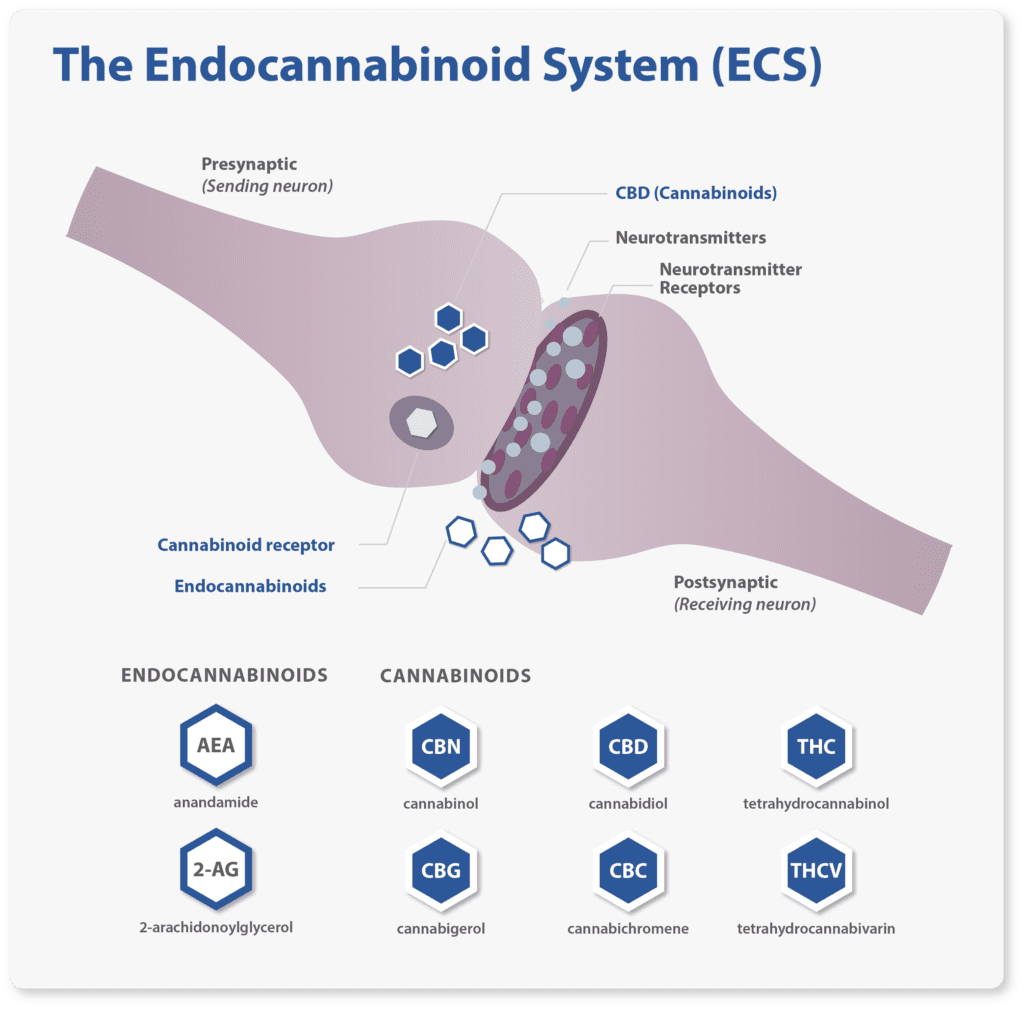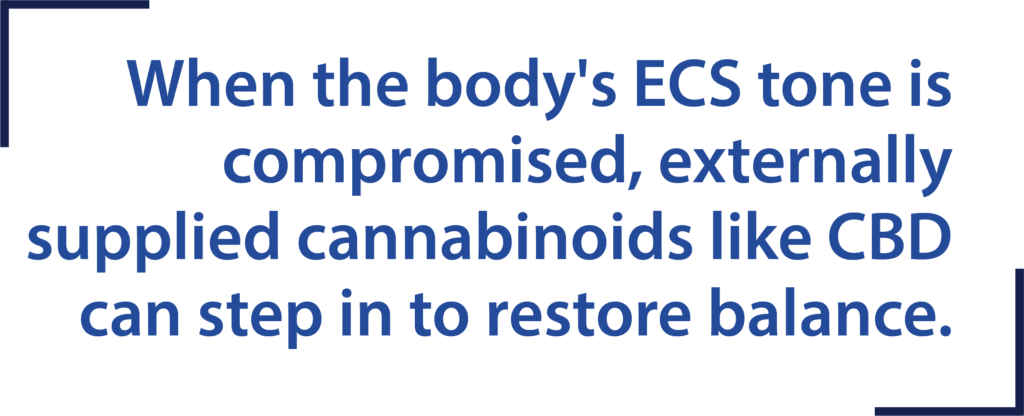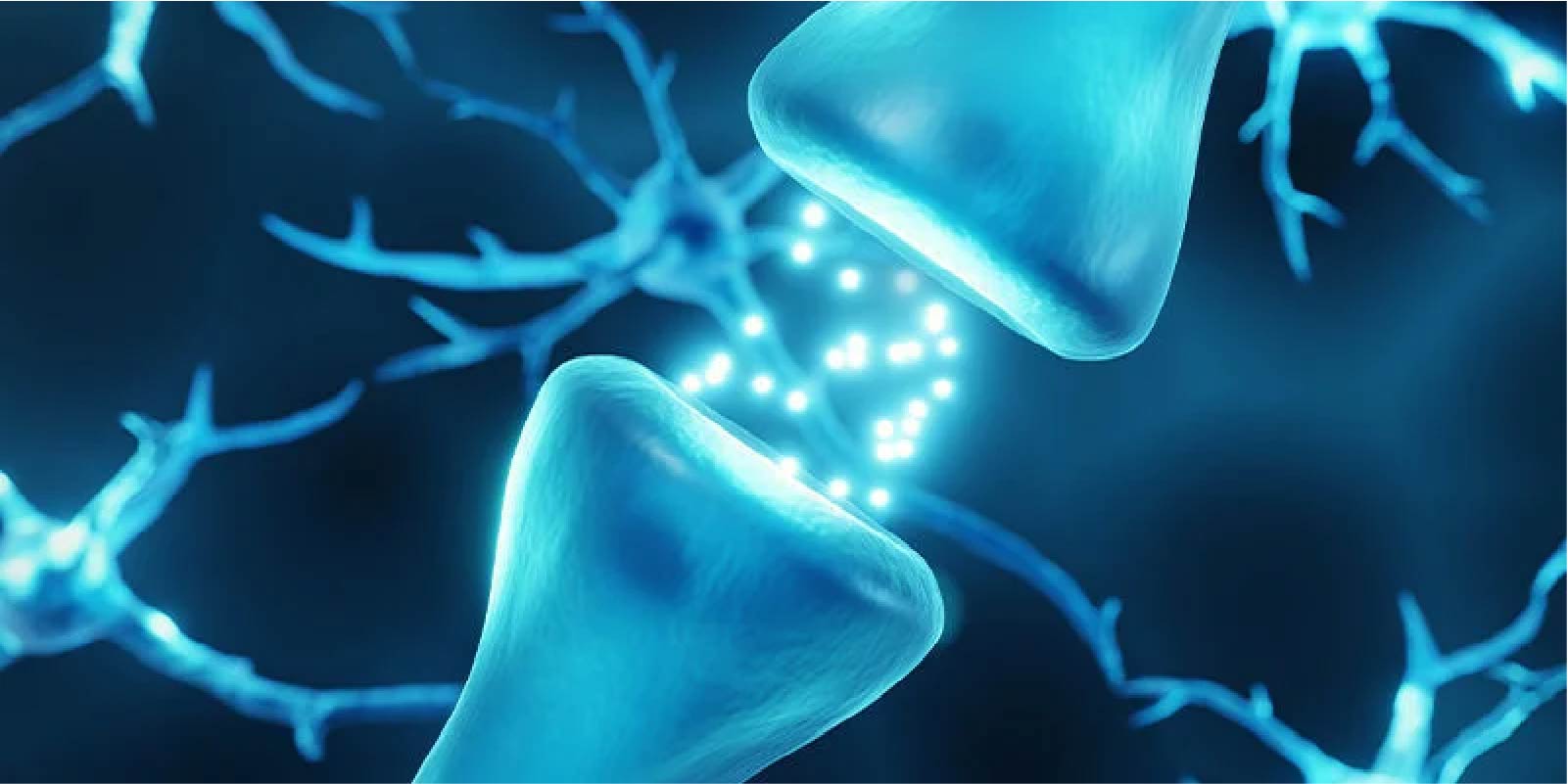The endocannabinoid system (ECS) is an intricate network within our bodies that regulates various physiological processes. While the body’s ECS naturally produces its own cannabinoids, known as endocannabinoids, external cannabinoids derived from the cannabis plant, such as CBD (cannabidiol), may also play a significant role in supporting the ECS. In this blog, we will explore how plant cannabinoids interact with the ECS, particularly beneficial when the body’s ECS tone is compromised, and explore some of the key therapeutic effects that these external cannabinoids have been shown to exhibit.
Understanding the Endocannabinoid System
The ECS comprises three main components: endocannabinoids, receptors, and enzymes. The two primary endocannabinoids are anandamide (AEA) and 2-arachidonoylglycerol (2-AG). These endocannabinoids bind to two main types of receptors, known as CB1 and CB2 receptors, which are found throughout the body. The enzymes FAAH (fatty acid amide hydrolase) and MAGL (monoacylglycerol lipase) break down the endocannabinoids once they have fulfilled their regulatory functions. Learn more about about the endocannabinoid system in this Your Body’s Internal Harmony Keeper blog.


Cannabinoids and the ECS
Phyto-cannabinoids, such as CBD (cannabidiol) and THC (tetrahydrocannabinol), found in the hemp plant can interact with the ECS by mimicking or modulating the actions of endocannabinoids. While THC has psychoactive properties and primarily binds to CB1 receptors, CBD does not produce a high and interacts with both CB1 and CB2 receptors, albeit in a more indirect manner.
Additionally, beyond the well-known cannabinoids like CBD and THC, the hemp plant offers a treasure trove of minor and acidic cannabinoids that can also interact with the body’s ECS. To highlight a few, CBDa (cannabidiolic acid), CBN (cannabinol), and CBG (cannabigerol) may complement the role of CBD and other prominent cannabinoids and potentially offer a broader spectrum of potential therapeutic benefits.
Supporting a Compromised ECS Tone
When the body’s ECS tone is compromised, meaning it is not producing sufficient endocannabinoids or the receptors are not functioning optimally, externally supplied cannabinoids like CBD can step in to restore balance. CBD enhances the ECS by inhibiting the enzymes responsible for breaking down endocannabinoids. This inhibition allows endocannabinoids to remain active in the body for a longer time, providing extended regulatory effects.
Therapeutic Effects of External Cannabinoids*
Cannabidiol has been studied for several decades, and due to growing recognition of the potential benefits of CBD and the relaxing of legal restrictions in some regions in recent years, there has been a significant increase in scientific literature exploring CBD’s therapeutic applications. Clinical trials, observational studies, and systematic reviews have been conducted to assess the safety, efficacy, and optimal dosing of CBD in different contexts.
Research studies on humans have investigated CBD’s potential in numerous areas, including:
- Pain and Inflammation: Cannabinoids, including CBD, have demonstrated analgesic and anti-inflammatory properties. They interact with CB1 and CB2 receptors to alleviate discomfort and modulate inflammation, making them promising candidates for managing chronic pain and inflammatory conditions [1].
- Anxiety and Mood: CBD has shown potential in reducing anxiety[2,3] and improving mood by modulating the ECS and impacting serotonin receptors. It may help individuals with generalized anxiety, social anxiety, and post-traumatic stress (PTSD), among others[3,4,5].
- Neuroprotective Effects: Research suggests that cannabinoids have neuroprotective properties, potentially benefiting those with a range of neurological challenges [6]. CBD in particular has garnered attention for its anti-seizure properties [6,7,8].
- Sleep Improvement: CBD may aid in improving sleep quality and addressing insomnia [9]. Studies have shown subjective findings of better sleep after the consumption of CBD [10]. Since many CBD products available contain full spectrum hemp, enhanced sleep may be attributed in part to the low concentrations of THC[11] as THC has shown to produce relaxing effects.
Cannabinoids in their acidic forms (precursors in the hemp plant, before exposure to heat) along with minor cannabinoids (typically present in the hemp plant in small concentrations) initially had limited research interest. However, more recent studies have shown that these compounds may complement the role of CBD and potentially offer both overlapping and unique therapeutic benefits. Learn more about additional cannabinoids in this Powerful Properties of CBDa blog and Exploring the Potential Health Benefits of CBG blog.
The investigation into additional phyto-cannabinoids—botanicals apart from hemp—that interact with the body’s endocannabinoid system is an area in its early stages of scientific exploration. While the endocannabinoid system was initially discovered in the context of cannabis and cannabinoids, it is now understood that the ECS interacts with various compounds found in other botanical sources as well. Therapeutic potential of these agents beyond the realm of cannabis were explored by Dr. Ethan Russo, a renowned neurologist and cannabis researcher. In this review, Dr. Russo sheds light on numerous other plants—such as black pepper, chili pepper, lemon balm and hops to mention a few—whose compounds interact with ECS receptors or influence the ECS indirectly [12].
Key Takeaways
The endocannabinoid system is a crucial regulatory network in the human body, and cannabinoids derived from the hemp plant play a vital role in supporting its functions. Beyond the endocannabinoids produced internally, externally supplied cannabinoids can restore balance to a compromised ECS tone. There is currently a body of scientific literature on favorable therapeutic effects of cannabinoids. Continued exploration in this field promises to unlock further potential applications of cannabinoids, offering hope for individuals seeking alternative treatment options for various health challenges.
References
- Atalay S, Jarocka-Karpowicz I, Skrzydlewska E. Antioxidative and Anti-Inflammatory Properties of Cannabidiol. Antioxidants (Basel). 2019 Dec 25;9(1):21. doi: 10.3390/antiox9010021. PMID: 31881765; PMCID: PMC7023045.
- Blessing EM, Steenkamp MM, Manzanares J, Marmar CR. Cannabidiol as a Potential Treatment for Anxiety Disorders. Neurotherapeutics. 2015 Oct;12(4):825-36. doi: 10.1007/s13311-015-0387-1. PMID: 26341731; PMCID: PMC4604171.
- Melas PA, Scherma M, Fratta W, Cifani C, Fadda P. Cannabidiol as a Potential Treatment for Anxiety and Mood Disorders: Molecular Targets and Epigenetic Insights from Preclinical Research. Int J Mol Sci. 2021 Feb 13;22(4):1863. doi: 10.3390/ijms22041863. PMID: 33668469; PMCID: PMC7917759.
- De Gregorio D, McLaughlin RJ, Posa L, Ochoa-Sanchez R, Enns J, Lopez-Canul M, Aboud M, Maione S, Comai S, Gobbi G. Cannabidiol modulates serotonergic transmission and reverses both allodynia and anxiety-like behavior in a model of neuropathic pain. Pain. 2019 Jan;160(1):136-150. doi: 10.1097/j.pain.0000000000001386. PMID: 30157131; PMCID: PMC6319597.
- Bergamaschi MM, Queiroz RH, Chagas MH, de Oliveira DC, De Martinis BS, Kapczinski F, Quevedo J, Roesler R, Schröder N, Nardi AE, Martín-Santos R, Hallak JE, Zuardi AW, Crippa JA. Cannabidiol reduces the anxiety induced by simulated public speaking in treatment-naïve social phobia patients. Neuropsychopharmacology. 2011 May;36(6):1219-26. doi: 10.1038/npp.2011.6. Epub 2011 Feb 9. PMID: 21307846; PMCID: PMC3079847.
- Campos AC, Fogaça MV, Sonego AB, Guimarães FS. Cannabidiol, neuroprotection and neuropsychiatric disorders. Pharmacol Res. 2016 Oct;112:119-127. doi: 10.1016/j.phrs.2016.01.033. Epub 2016 Feb 1. PMID: 26845349.
- Silvestro S, Mammana S, Cavalli E, Bramanti P, Mazzon E. Use of Cannabidiol in the Treatment of Epilepsy: Efficacy and Security in Clinical Trials. Molecules. 2019 Apr 12;24(8):1459. doi: 10.3390/molecules24081459. PMID: 31013866; PMCID: PMC6514832.
- Jones NA, Hill AJ, Smith I, Bevan SA, Williams CM, Whalley BJ, Stephens GJ. Cannabidiol displays antiepileptiform and antiseizure properties in vitro and in vivo. J Pharmacol Exp Ther. 2010 Feb;332(2):569-77. doi: 10.1124/jpet.109.159145. Epub 2009 Nov 11. PMID: 19906779; PMCID: PMC2819831.
- Chagas MH, Crippa JA, Zuardi AW, Hallak JE, Machado-de-Sousa JP, Hirotsu C, Maia L, Tufik S, Andersen ML. Effects of acute systemic administration of cannabidiol on sleep-wake cycle in rats. J Psychopharmacol. 2013 Mar;27(3):312-6. doi: 10.1177/0269881112474524. Epub 2013 Jan 23. PMID: 23343597.
- Shannon S, Lewis N, Lee H, Hughes S. Cannabidiol in Anxiety and Sleep: A Large Case Series. Perm J. 2019;23:18-041. doi: 10.7812/TPP/18-041. PMID: 30624194; PMCID: PMC6326553.
- Kesner AJ, Lovinger DM. Cannabinoids, Endocannabinoids and Sleep. Front Mol Neurosci. 2020 Jul 22;13:125. doi: 10.3389/fnmol.2020.00125. PMID: 32774241; PMCID: PMC7388834.
- Russo, Ethan B. “Beyond Cannabis: Plants and the Endocannabinoid System.” Trends in Pharmacological Sciences, vol. 37, no. 7, 2016, pp. 594–605, https://doi.org/10.1016/j.tips.2016.04.005.

